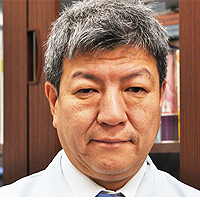The rising role of mesenchymal stem cells in the treatment of COVID-19 infections
Published on: 7th July, 2020
OCLC Number/Unique Identifier: 8623431074
Infectious diseases are a leading cause of death worldwide [1,2]. The Mid-20th century witnessed most of the antimicrobial discoveries but recently there is dramatic shortage of new classes of antimicrobial agents due to failure to build a sustainable antimicrobial discovery platform [1-4]. For example, antibiotics comprise ˂ 1.5% of the compounds under investigation at the major pharmaceutical and biotechnology companies [1,5].
Diagnosis of Asthma in Childhood Age
Published on: 13th September, 2018
OCLC Number/Unique Identifier: 7878010008
Background: Asthma is the most common chronic respiratory disorder in childhood. Asthmatic attacks are described and classified according to the type of wheezing to Non –atopic and Atopic asthma (IgE mediated wheezing). The aim of this review is to determine the onset of clinical diagnosis in relation to clinical presentation of asthma in children and obstacles related to delay of Asthma diagnosis.
Methods: This review highlights the results of studies done regarding clinical diagnosis in relation to clinical presentation and of asthma in children. An extensive search has been conducted for researches about asthma in children. This search based on the publications posted on the National Center for Biotechnology Information PubMed or by Google Scholar. Key words used for the research: Asthma, clinical diagnosis, children.
Results and Conclusion: Diagnosing asthma in young children is difficult because children often cough and wheeze with colds and chest infections, but this is not necessarily asthma. Miss diagnosis of asthma in children occurs when physicians diagnose patients with asthma from the clinical diagnosis in the first attack without excluding other asthma mimickers which can be any other respiratory problem. There is over-diagnosis of asthma due to the symptoms which mimic other respiratory infections. First episodes of cough, runny nose and fever that happen in cold/flu season- fall/winter/early spring is likely not asthma. If the child has several more episodes of wheeze and cough, it is likely to be asthma. Since there is no diagnostic test available for children younger than 6 years of age, making a diagnosis in this age group is more difficult than in older children. Over the age of about 6 years it is possible for a child to have a spirometer test
The Daring of Biosimilars
Published on: 1st May, 2017
OCLC Number/Unique Identifier: 7317653965
The so-called “biotechnological revolution” is changing the structure of the Pharmacopoeia [1]. The space of biological products, previously limited to blood products and vaccines, grew from the introduction of first recombinant therapeutics in the 1980s until attaining a 25% by value of the pharmaceutical market. This share is expected to reach 50% in the coming years. More than 80 biotechnology drugs have entered the market in the last ten years. It is estimated that there are more than 900 biological products on development for more than 100 diseases [2].
Synthetic Animal: Trends in Animal Breeding and Genetics
Published on: 11th January, 2019
OCLC Number/Unique Identifier: 7976985981
Synthetic biology is an interdisciplinary branch of biology and engineering. The subject combines various disciplines from within these domains, such as biotechnology, evolutionary biology, molecular biology, systems biology, biophysics, computer engineering, and genetic engineering. Synthetic biology aims to understand whole biological systems working as a unit, rather than investigating their individual components and design new genome. Significant advances have been made using systems biology and synthetic biology approaches, especially in the field of bacterial and eukaryotic cells. Similarly, progress is being made with ‘synthetic approaches’ in genetics and animal sciences, providing exciting opportunities to modulate, genome design and finally synthesis animal for favorite traits.
Current challenges in plant breeding to achieve zero hunger and overcome biotic and abiotic stresses induced by the global climate changes: A review
Published on: 28th July, 2021
OCLC Number/Unique Identifier: 9204610537
According Sustainable Development goals until 2030 we should have zero hunger and undernourished people in the world. But to achieve this goal plant breeders must improve plants in order to produce at least the double than is produced now. This is not a easy pathway because we have only few years, but considering that plant breeding programs normally take several years to produce improved genotypes, also the further improved plants should face with pest, disease and other abiotic factors that are increasing with the current climate changes. In this review we will discuss the situation of hunger in the world and the remaining available land to increase food production, point out effects of biotic and abiotic factors on the food production and present some ways that can be used to fastening plant breeding.
High-Performance Liquid Chromatography (HPLC): A review
Published on: 20th June, 2022
Today HPLC is widely applied for separations and purifications in a variety of areas including pharmaceuticals, biotechnology, environmental, polymer and food industries. It is accomplished by injection of a small amount of liquid sample into a moving stream of liquid (called the mobile phase) that passes through a column packed with particles of the stationary phase. The separation of a mixture into its components depends on different degrees of retention of each component in the column. HPLC is just one type of liquid chromatography, meaning the mobile phase is a liquid. Reversed-phase HPLC is the most common type of HPLC. The reversed-phase means the mobile phase is relatively polar, and the stationary phase is relatively non-polar. HPLC instrumentation includes a Solvent reservoir, pump, injector, column, detector, and integrator or acquisition and display system. The heart of the system is the column where separation occurs. The information that can be obtained using HPLC includes identification, quantification, and resolution of a compound. The major applications are in the area of Pharmaceuticals, food, research, manufacturing, forensics, and bio-monitoring of pollutants.
Role of CRISPR-Cas9 in agricultural science
Published on: 23rd December, 2022
Clustered regularly interspaced short palindromic repeat (CRISPR), a potent gene-editing tool was found in 2012. CRISPR is a genetic engineering technique that enables genome editing in living creatures and is based on the bacterial CRISPR-Cas9 antiviral defense mechanism. It is simpler, less expensive, and more accurate than previous gene editing techniques. It also has a wide range of valuable uses, including improving crops and treating genetic diseases. Plant science has benefited more from the CRISPR/Cas9 editing technique than medical science. CRISPR/Cas9 has been used in a range of crop-related research and development domains, including disease resistance, plant development, abiotic tolerance, morphological development, secondary metabolism, and fiber creation, as a well-developed cutting-edge biotechnology technique. This paper summarized the role of the CRISPR-CAS9 tool in modern agricultural science.
Significance and Prospect of Brf1 Overexpression
Published on: 22nd August, 2023
Brf1 (TFIIB-related factor 1) is a transcription factor, which specifically modulates the transcription of RNA polymerase III-dependent genes (RNA Pol III genes), such as tRNAs and 5S rRNA. The products of tRNAs and 5S rRNA transcription will be changed with the alteration of Brf1 expression. Whereas deregulation of Brf1 and RNA Pol III genes are tightly associated with cell proliferation and transformation, and tumorigenesis. In recent years, emerging studies indicate that Brf1 expression is increased in patients with cancers. In this review, we summarize the progress of the abnormal expression of Brf1 in different human cancers to explore an underlying mechanism and its clinical implication, as well as to prompt its application prospect. With the depth of the Brf1 study and the progress of biotechnology, the status of Brf1 expression may be used as a universal indicator of the early detection and prognosis observation of human cancers.
Evolution of Antifungal Activity of Artemisia herba-alba Extracts on Growth of Aspergillus sp. and Rhizopus sp.
Published on: 11th February, 2025
Plant extracts and their constituents have a long history as antifungal agents, but their use in biotechnology as preservatives, due to the increasing resistance of fungi to fungicides, has been rarely reported in Libya. The aim of this study is to evaluate the antifungal activity of ethanol extract and water extract of the wild native plant Artemisia herba-alba against two genera of mold fungi Aspergillus sp. and Rhizopus sp. This mold fungal causes significant damage to crops in the field or during storage. In this study, a hot ethanol extract was prepared using a device Soxhlet, and water extract hot as well as a cold ethanol extract and cold-water extract aqueous extract three concentrations (25% - 50% - 75%) of plant extracts were used on the tested fungi. All extracts showed an effect on the tested fungi. The concentrations of (75% - 50%) of the extracts had an effect on the tested fungi, while most concentrations of 25% of the extracts did not record any effect on the tested fungi. The hot ethanol extract of the Artemisia herba-alba plant was more effective than the other extracts. Aspergillus sp. was recorded with the highest inhibitory zone (0.73 mm).
Biotechnology in Forensic Science: Advancements and Applications
Published on: 25th February, 2025
Background: Biotechnology is a multidisciplinary field based on the expertise of molecular biology, chemistry, biochemistry, chemical and biological engineering, and digital computing. Biotechnology plays an important role in modern forensic science, driving advances in analytical tools and techniques.This review study provides a brief overview of applications, highlighting advances in forensic biotechnology and key technologies involved in the domains of genomics and DNA analysis, microbial forensics, forensic medicine, and forensic serology. The integration of forensic expertise with technology has increased the accuracy, sensitivity, and efficiency of forensic casework.Conclusions: This interdisciplinary field extends beyond its usual association with biology to also include chemistry, fingerprint analysis, and toxicology, among others. Continued progress and innovation in this advanced field will further enhance investigative capabilities and facilitate the pursuit of justice.
Redefining Biotechnology for the Global South: The Role of Synthetic Biology and Computational Tools
Published on: 26th May, 2025
Biotechnology has always played an important role in tackling global concerns, particularly in the Global South, where socioeconomic gaps sometimes stymie scientific progress. Recent advances in synthetic biology and computational technologies have the potential to revolutionize biotechnology in these locations. Synthetic biology allows for the creation and manipulation of biological systems, with promise applications in healthcare, agriculture, and environmental control. Computational methods such as machine learning and artificial intelligence help to optimize synthetic biology processes, enabling innovations that are suited to local requirements. The combination of these cutting-edge technologies with traditional biotechnological techniques has the potential to dramatically improve the Global South's ability to solve issues such as disease outbreaks, food security, and sustainable development. This abstract outline the critical intersections of synthetic biology and computational advancements and their potential to empower the Global South, highlighting the need for supportive policies and capacity-building initiatives to maximize their impact.




